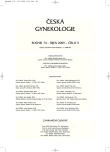Acute hysterectomy for huge submucous leiomyoma prolaps
Authors:
P. Zielina; R. Schreier
Authors‘ workplace:
Gynekologicko-porodnické oddělení nemocnice Třinec, primář MUDr. R. Schreier
Published in:
Ceska Gynekol 2009; 74(5): 389-392
Overview
Objective:
To present a case of huge submucous leiomyoma prolaps to the vagina with severe haemorrhage and its management and to analyse current articles with this rare complication.
Design:
A case report, review article.
Setting:
Department of Gynecology and Obstetrics Třinec Hospital.
Results:
A case report of huge submucous leiomyoma prolaps in 49-year-old woman. The patient presented at our department with sudden onset of profuse vaginal bleeding. The vaginal and utrasound examination was performed with diagnosis of huge submucous leiomyoma obturating upper third of the vagina. The cervix was not palpable, rised up. While manipulating with the leiomyoma the bleeding exceeded. The patient agreed with abdominal hysterectomy without adnexectomy. Then the patinent colapsed and the operation was performed immediately, taking care of changed anatomy – the line between the vaginal wall and the uterus was almost invisible caused by „non-existing cervix“ and the uterus was partialy inverted into the vagina. The haemoglobin level falled from 124 g/l to 95 g/l with no need of tranfusion. The patient quickly recovered and was dimised the sixth day after the operation.
Conclusion:
Uterine myomas in their submucous localisation may protrude through the cervix into the vagina and cause rare but very serious complications - profuse vaginal bleeding and non-puerperal inversion of the uterus, and thus need very urgent management.
Key words:
submucous leiomyoma, prolaps, non-puerperal inversion of the uterus.
Sources
1. ACOG practice bulletin. Alternatives to hysterectomy in the management of leiomyomas. Obstet Gynecol, 2008, 112, 2, p. 387-398.
2. Friedman, AJ. Acute urinary retention after gonadotropin-releasing hormone agonist treatment for leiomyomata uteri. Fertil Steril, 1993, 59, 3, p. 677-678.
3. Holub, Z., Kužel, D., Kučera, E., et al. Management děložních myomů: CSGE doporučení k provádění správné klinické praxe. Čes Gynek, 2005, 70, 2, s. 165-167.
3. Chen, YL., Chen, CA., Cheng, WF., et al. Submucous myoma induces sterine inversion. Taiwan J Obstet Gynecol, 2006, 45, 2, p. 159-161.
4. Kim, JW., Lee, CH., Kim, KA., et al. Spontaeous prošlape of pedunculated sterine submucosal leiomyoma: usefulness of brodili sign on CT or MR imaging. Clin Imaging, 2008, 32, 3, p. 233-235.
5. Kriplani, A., Agarwal, N., Parul, D., et al. Prolapsed leiomyoma with severe haemorrhage after GnRH analogue therapy. J Obstet Gynecol, 2002, 22, 4, p. 449-451.
6. Kubínová, K., Mára, M., Horák, P., et al. Novinky a perspektivy v radiologické léčbě děložních myomů. Čes Gynek, 2009, 74, 1, s. 22-26.
7. Kužel, D., Tóth, D., Hrazdírová, L., et al. „See and treat“ hysteroskopie: limity velikosti intrauterinní patologie. Čes Gynek, 2006, 71, 4, s. 325-328.
8. Kužel, D., Tóth, D., Fučíková, Z., et al. Hysteroskopická resekce submukózních myomů při abnormálním děložním krvácení: výsledky čtyřleté prospektivní studie. Čes Gynek, 1999, 64, 6, s. 363-367.
9. Mára, M., Fučíková, Z., Mašata, M., et al. Management děložních myomů u žen ve fertilním věku. Čes Gynek, 2003, 68, 1, s. 30-36.
10. Mára, M., Mašková, J., Fučíková, Z., et al. Praktické poznámky k embolizaci děložních myomů. Čes Gynek, 2007, 72, 1, s. 58-64
11. Mazadel, NM., Tank, PD. Non-puerperal incomplete lateral uterine inversion with submucous leiomyoma: a case report. J Obstet Gynecol Res, 2003, 29, 4, p. 243-245.
12. Rosales Aujang, E., González Romo, R. Non-puerperal uterine inversion. Report of a case. Ginecol Obstet Mex, 2005, 73, 6, p. 328-331.
13. Skinner, GN., Louden, KA. Non-puerperal uterine inversion associated with atypical leiomyoma. Aust N Z J Obstet Gynecol, 2001, 41, 1, p. 100-101.
14. Wang, KC., Lee, WL., Juan, CC., et al. Major hemorrhagie in a patient with multiple submucous leiomyomata dutiny the treatment of long-acting gonadotropin-releasing hormone agonist. Kaohsiung J Med Sci, 2000, 16, 2, p. 103-107.
15. Wen, L., Tseng, JY., Wang, PH., et al. Vaginal expulsion of a submucosal myoma dutiny treatment with long-acting gonadotropin-releasing hormone agonist. Taiwan J Obstet Gynecol, 2006 45, 2, p. 173-175.
16. Yu, KJ., Lai, CR., Sudu, MH. Spontaneous expulsion of a uterine submucosal leiomyoma after administration of a gonadotropin-releasing hormone agonist. Eur J Obstet Gynecol Reprod Biol, 2001 96, 2, p. 223-225.
Labels
Paediatric gynaecology Gynaecology and obstetrics Reproduction medicineArticle was published in
Czech Gynaecology

2009 Issue 5
Most read in this issue
- Current knowledge of ductal carcinoma in situ
- Acute hysterectomy for huge submucous leiomyoma prolaps
- Cancer of endometrium - rare variant of remote metastases
- Early pregnancy loss and inherited thrombophilic states
